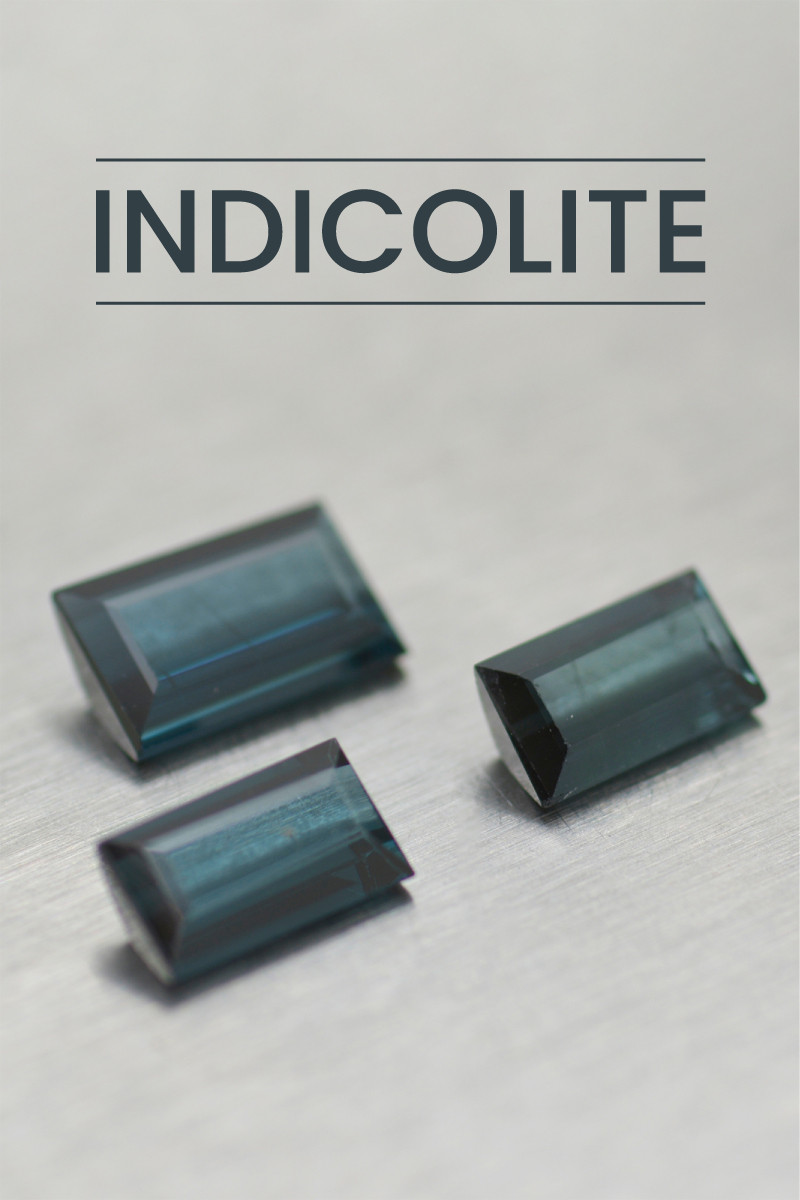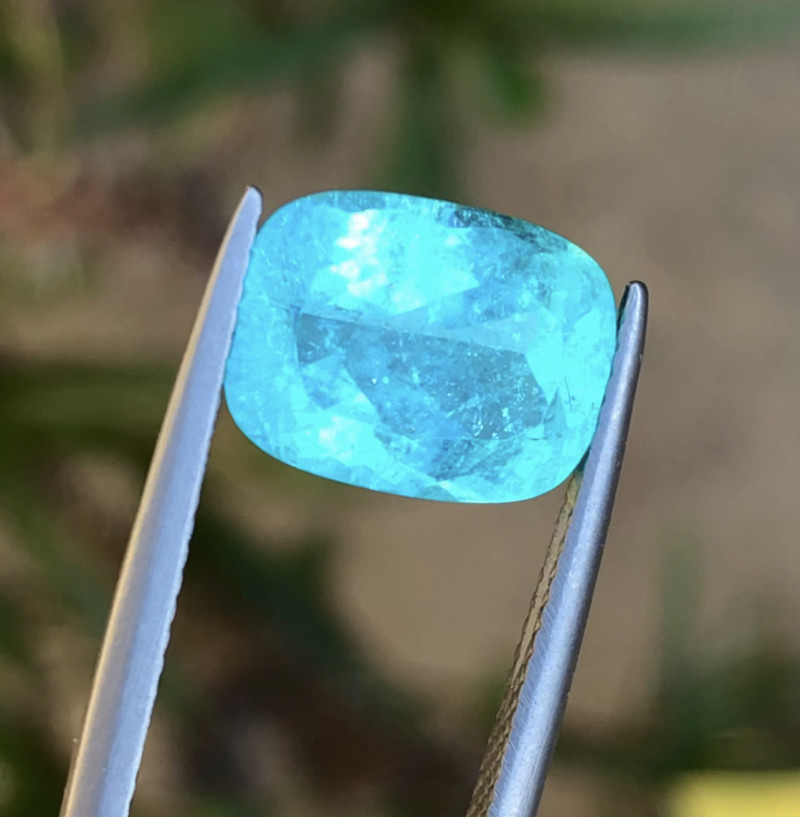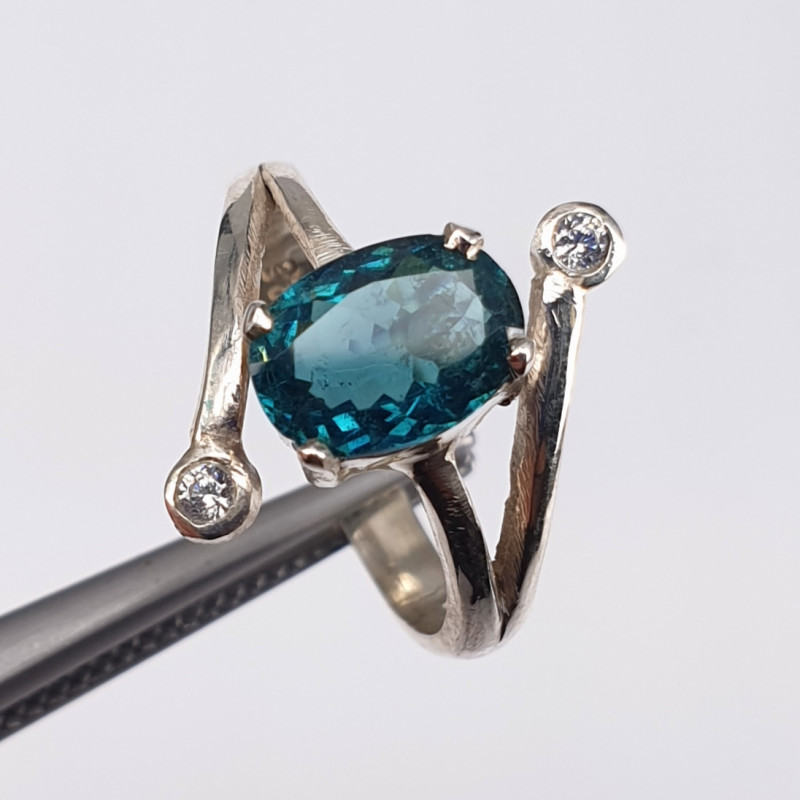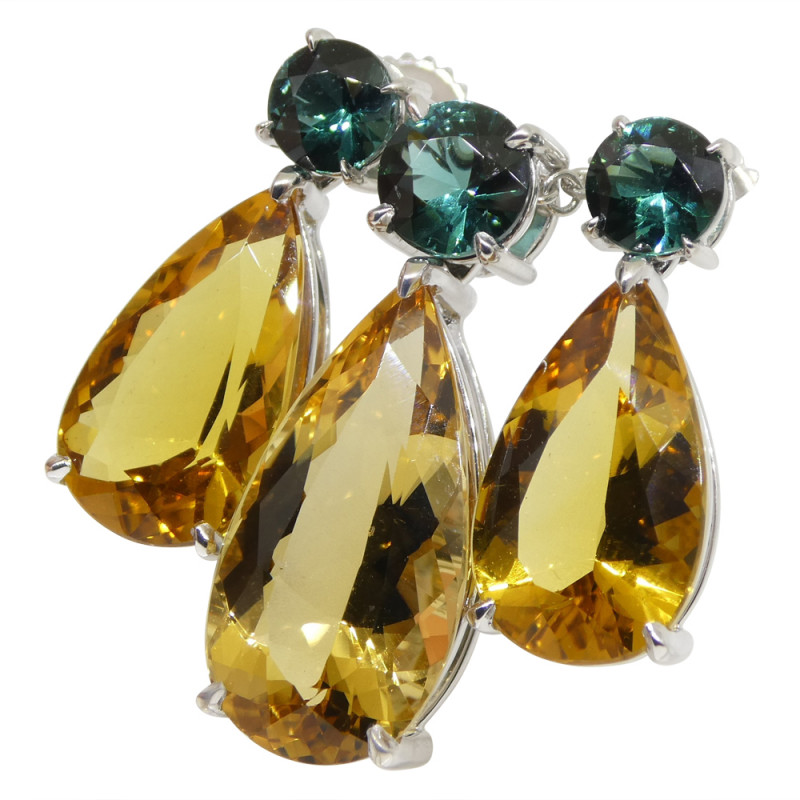
蓝靛宝石:特性、含义、价值等
 蓝靛石(发音:in-duh-KOH-lite)是复杂的碧玺家族中的一种矿物。但蓝靛石本身也是宝石吗?是的!蓝靛石以各种形状和珠宝的形式出现。
蓝靛石(发音:in-duh-KOH-lite)是复杂的碧玺家族中的一种矿物。但蓝靛石本身也是宝石吗?是的!蓝靛石以各种形状和珠宝的形式出现。
碧玺家族复杂而广泛。有些碧玺以其独特的颜色而闻名,例如棕色至黑色的黑碧玺系列。
蓝碧玺是什么颜色的?这种碧玺的颜色呈蓝色,有时带有绿色底色。
那么,蓝色碧玺和蓝碧玺一样吗?一般来说,是的。蓝碧玺通常被称为“蓝色碧玺”。
碧玺是色彩最丰富的矿物,但蓝碧玺真的是一种罕见的颜色吗?没错,蓝色其实是碧玺中最稀有的颜色。
在浏览出售的蓝靛碧玺之前,准备好深入探索蓝靛碧玺了吗?加入我们,一起了解蓝靛碧玺的属性、价格、含义和分级。

关于靛蓝石
蓝碧玺是一种半宝石,尽管巴西蓝碧玺有时也被称为“巴西蓝宝石”,因为它的外观与蓝宝石相似。然而,蓝宝石是独立的宝石,将碧玺标记为蓝宝石违反了联邦贸易委员会(FTC)的规定。
话虽如此,由于靛蓝石与蓝宝石相似,因此它成为传统 九月诞生石和40 周年结婚纪念宝石的更实惠的替代品。
蓝靛石是一种碧玺,是传统的十月诞生石、八周年结婚纪念石和天秤座的守护石。蓝靛石也对金牛座、狮子座和天蝎座有利,同时也是水星和冥王星的星石。
此外,碧玺是美国缅因州的州矿物。这种宝石的其他别名包括“靛蓝石”和“碧玺”。
听说过田园风或暗黑学院风之类的美学风格吗?“Indicolite”是另一个以水晶命名的美学风格,它是一种优雅的美学风格,融合了复古蓝调、闪光和水元素。
说到元素,让我们来了解一下蓝靛石的组成元素和石头的矿物特性。

靛蓝石规格和特性
碧玺家族十分复杂,与石榴石类似,其主要家族下又包含多个品种。就连碧玺的化学式也很复杂:Na(Li,Al)1.5Al6(Si6O18)(BO3)3(OH)3(OH)。
蓝碧玺是锂电气石系列(或品种)中的一种复合硼硅酸盐。锂电气石是最常见的宝石级系列,含有铝、钠和锂。除了蓝碧玺,其他常见的锂电气石宝石包括绿碧玺、西瓜碧玺,以及常见的红碧玺。
其他重要的碧玺系列是黑碧玺和镁电气石。
蓝碧玺晶体通常呈棱柱状。碧玺晶体则以沿长面垂直延伸的清晰条纹(表面长凹槽)而闻名。此外,沿着这些长面或横截面,像蓝碧玺这样的碧玺通常呈现出色域。
碧玺的独特之处还在于它有时会形成三面棱柱体或异形体,这意味着晶体的尖端和底部具有不同的形状。
以下是剩余的靛蓝石矿物特性:
莫氏硬度:7-7.5
颜色:蓝色、绿蓝色或蓝绿色
晶体结构:三方
光泽:玻璃质(玻璃状)
透明度:透明至不透明
折射率:1.62-1.64
密度:2.90-3.10
解理: [1120] 和 [1011] 较差/不明显
断口:贝壳状
条痕:白色
发光:荧光有时会出现,但很弱 - 在短波紫外和长波紫外中呈蓝绿色
多色性:在深蓝色至浅蓝色中表现明显且强烈
双折射率:0.014-0.022
分散性:0.017(中等)
光学效应:可能存在猫眼现象
 上图:帕拉伊巴碧玺
上图:帕拉伊巴碧玺
靛青石与帕拉伊巴碧玺
我们上面没有提到的另一种锂电气石系列宝石是帕拉伊巴碧玺,或称“铜锂电气石”。帕拉伊巴碧玺是一种饱和度极高的霓虹蓝色、蓝绿色或紫色碧玺,因 20 世纪 80 年代在巴西帕拉伊巴州发现而得名。
尽管帕拉伊巴碧玺的名称源于其产地,但严格意义上来说,它的定义取决于其铜含量。因此,巴西以外的地区也发现了并开采帕拉伊巴碧玺。最珍贵的帕拉伊巴碧玺呈电蓝色或紫色。
靛蓝碧玺和帕拉伊巴碧玺有何区别?
首先,帕拉伊巴石以其更加鲜艳饱和的色彩而闻名,其颜色不仅局限于蓝色和绿色,甚至还带有紫色。帕拉伊巴石的颜色源于铜(紫色中加入了锰),而蓝铜矿的颜色则来自铁。
其次是稀有性。虽然所有蓝色碧玺都很稀有,但帕拉伊巴碧玺却是所有碧玺中最稀有的。这反映在其价格上,因为优质碧玺的价格可能是同等大小的优质蓝碧玺的6倍。
澄清了这个重要的区别之后,我们接下来将深入探讨靛蓝石在整个时间范围内的象征意义!

靛蓝石的意义和历史
蓝靛石象征着灵感、开放的思想和同理心。
纵观历史,人们将许多民间传说与碧玺联系在一起。古埃及传说声称,碧玺的彩虹色源于它从地心运行,然后沿着彩虹吸收光谱。
在更现代的时代,蓝靛石被各种群体视为幸运护身符。人们还相信它能够提升创造潜力,因此在创意领域颇受青睐。
1800 年,巴西矿物学家 José Bonifácio de Andrada e Silva 以拉丁语indicum (意为“靛蓝”)命名了靛蓝矿。这比 1913 年俄罗斯矿物学家 Vladimir Ivanovich Verdadsky 以意大利海岸外的厄尔巴岛命名的锂电气石系列要早得多。
碧玺自古以来备受人们喜爱,以至于蓝碧玺究竟何时被正式发现都不得而知。事实上,它可能曾被误认为是其他宝石,就像众所周知的那样,碧玺曾被误认为是其他几十种宝石。
无论如何,如今蓝靛晶被用于珠宝、装饰,当然还有水晶治疗!

蓝靛石的治疗功效
与所有宝石一样,蓝碧玺也具有疗愈功效。蓝碧玺与其他蓝色宝石一样,能够促进宁静、同理心和诚实。绿色调则带来与 绿色宝石相关的好运、平衡和积极能量。
那么靛蓝石的物理、情感和脉轮治疗能力如何呢?
身体康复
从物理角度来看,靛蓝被认为可以治疗:
烧伤
头痛
失眠
头晕
疤痕
感染
情绪疗愈
从情感上来说,靛蓝水晶可以让你更有耐心,更宽容。据说它们能帮助你治愈创伤,让你以更包容的心态面向未来而非过去。它被认为能解放你的心灵,让你摆脱自我怀疑,探索自身的潜能。
脉轮疗愈
脉轮治疗是一个古老的过程,涉及打开身体上的一个或多个能量中心(脉轮)以解决与脉轮阻塞或不平衡相关的负面症状。
蓝靛石是喉轮石,是真理、理解和沟通的能量中心。一旦蓝靛石打开脉轮,它就会引导你更好地理解和表达最真实的自我。
当然,你需要买一块蓝宝石才能开始治疗,对吧?为了确保物有所值,了解蓝宝石的特性至关重要。

靛蓝石宝石属性
虽然电气石的分级很复杂,有些主观,并且可能随着需求而变化,但碧玺的价值一般分为颜色、切工、净度、克拉重量和处理方式。
颜色
大多数蓝靛蓝宝石都带有绿色底色,因此纯蓝色蓝靛蓝宝石价值最高。其饱和度从浅灰色到鲜艳色不等。虽然饱和色调最佳,但颜色必须足够浅,才能看到其多色性、闪烁度和透明度。
因此,许多颜色较深的宝石或带有绿色底色的宝石都经过处理,以使其颜色更有价值。
切
刻面靛蓝宝石有时颇具挑战性,因为切磨师必须精准地调整宝石方向,才能最大程度地展现其多色性和色散(色彩的闪烁)。对于深色宝石而言,这一点尤其困难。
浅色样本几乎可以进行任何刻面切割,其中祖母绿形、椭圆形、垫形和异形切割较为常见。圆形明亮式或棋盘格形切割非常适合高饱和度、较大的宝石材料。
猫眼石必须切割成凸圆形才能完美展现其“猫眼”的光泽。否则,低品质的猫眼石可能会被雕刻、打磨或留下未加工的痕迹。
明晰
蓝碧玺的净度等级为II型,这意味着高品质的碧玺通常肉眼看不到内含物,但其他碧玺通常含有少量内含物。在各种碧玺颜色中,蓝色和绿色碧玺通常净度更高。
靛蓝石中可能含有的内含物或杂质包括:
色域
长而薄的液体和气体包裹体
充满气体的反射裂缝
大多数内含物都会降低价值,但纤维状的针状晶体(通常是金红石)束会形成猫眼效应,从而形成相当有价值的“猫眼碧玺”。猫眼碧玺的价值取决于反射“猫眼”的清晰度,以及宝石的颜色、大小和透明度。
克拉重量和尺寸
靛蓝石的克拉重量范围很广,但每克拉的价格范围是不同的。0.4 至 2 克拉的宝石有一个价格范围,而 2 至 10 克拉或以上的宝石价格范围更高。凸圆形宝石通常重量为 2 克拉或更大。
总体而言,几乎任何预算都可以买到各种尺寸的靛蓝宝石。
处理剂、合成物和仿制品
目前市场上出售的大多数蓝色电气石都经过了热处理和/或辐照处理,通常被贴上“蓝冰”之类的标签。
加热和辐射会使靛蓝碧玺的颜色变浅,从而提高透明度和亮度。帕拉伊巴碧玺通常经过加热才能呈现出霓虹色。这些新颜色在碧玺中很稳定。
其他与宝石坚固性相关的处理方法包括裂缝填充(通常使用树脂或油),以改善宝石的净度并隐藏瑕疵。这种方法在内含物较多的宝石中更为常见。
并非所有卖家都会披露宝石的处理方式,但有一些线索可供参考。如果您有多颗看起来一模一样的靛蓝石,那么它们很可能经过了处理——未经处理的宝石每颗看起来都略有不同。其次,在直射光下转动宝石时,如果颜色发生变化,通常也表明宝石未经处理。
虽然合成碧玺在珠宝市场上并不常见,但不同的宝石可能会被染色或其他处理,然后作为仿制品出售。例如绿碧玺(另一种碧玺)、尖晶石和石英。

靛蓝石的形成和来源
碧玺生长于地下。岩浆加热地下水,导致矿物质溶解。水将这些溶解的矿物质带入岩石缝隙,然后蒸发,形成晶体。
如果微量元素的类型或数量在形成过程中发生变化,就会出现颜色分区。
锂电气石类似于靛蓝电气石,形成于变质岩和火成岩中,如花岗岩伟晶岩和片岩,以及热液矿床中。
采矿地点
蓝碧玺产自哪里?虽然许多地方都出产蓝碧玺,但最好的宝石原料来自巴西和斯里兰卡。
宝石级靛蓝石的其他来源包括:
阿富汗
马达加斯加
墨西哥
莫桑比克
纳米比亚
尼日利亚
巴基斯坦
俄罗斯
美国(加利福尼亚州和缅因州)
 上图:靛蓝和金绿宝石首饰
上图:靛蓝和金绿宝石首饰
蓝靛石的价格和价值
最有价值的蓝靛蓝具有纯蓝色、肉眼无瑕的清晰度、良好的切工,可以很好地显示光学特性,并且(通常)不经过任何处理。
重量为 0.4 至 2 克拉的刻面靛蓝碧玺每克拉价格为 50 至 500 美元(相比之下,顶级帕拉伊巴碧玺宝石每克拉价格为 30,000 美元)。
重量为2克拉或以上的刻面宝石每克拉售价50至1,000美元。普通的靛蓝凸圆形宝石每克拉售价100至150美元。猫眼凸圆形宝石每克拉售价在30至200美元之间。
原始靛蓝晶体的批发价格为每克拉 4 至 20 美元。
靛蓝石的保养和维护
幸运的是,蓝靛石的宝石保养相当简单。任何珠宝都适合日常佩戴,即使是比较脆弱的蓝靛石戒指或手链也一样。
唯一需要特别护理的是经过处理的宝石。已填充裂缝的宝石应远离机械清洁器(例如超声波或蒸汽清洁器)和刺激性化学品。
用温水、温和的肥皂和软毛牙刷清洁靛蓝石。彻底冲洗,然后用柔软的超细纤维布擦干。
碧玺对极热和骤变的温度敏感。请将碧玺存放在相对阴凉的地方,避免阳光直射和存放其他宝石。

受到 Indicolite 的启发?
无论您是钟爱蓝色,还是喜爱碧玺,亦或只是想要一颗如大海般闪耀的宝石,蓝靛蓝都是您的理想之选。它拥有适合各种个性的色调和鲜艳度,价格范围也十分广泛,几乎涵盖所有预算。
搜索Gemstone Encyclopedia
最新的文章
棕榈象牙雕刻,又称植物象牙,是象牙的天然替代品,取自南美洲棕榈树(Phytelephas palm)的果实,并以符合伦理的方式采集。本指南将带您全面了解棕榈象牙!
15th Jan 2026
彩虹格纹日光石是一种长石,由于内部含有各种包裹体,呈现出三种绚丽的光学效应。它绚丽多彩的光泽和格纹图案使其成为收藏家梦寐以求的珍宝!
12th Jan 2026
文章分类
How To's is where you will find helpful articles from gem Rock Auctions on how to cut gemstones, select gemstones and buy gemstones.
9文章数




